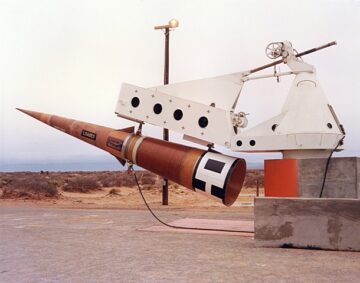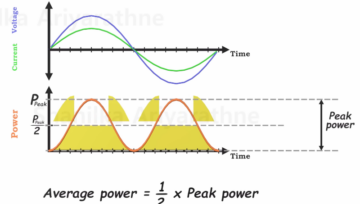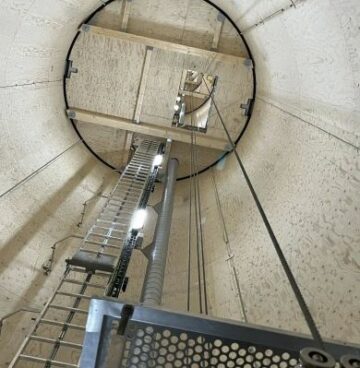
Mark it on your calendars, folks — this is the week that the term RUD has entered the public lexicon. Sure, most of our community already knows the acronym for “rapid unscheduled disassembly,” and realizes its tongue-in-cheek nature. But given that the term has been used by Elon Musk and others to describe the ignominious end of the recent Starship test flight, it seems like RUD will catch on in the popular press. But while everyone’s attention was focused on the spectacular results of manually activating Starship’s flight termination system to end its by-then uncontrolled flight at a mere 39 km, perhaps the more interesting results of the launch were being seen in and around the launch pad on Boca Chica. That’s where a couple of hundred tons of pulverized reinforced concrete rained down, turned to slag and dust by the 33 Raptor engines on the booster. A hapless Dodge Caravan seemed to catch the worst of the collateral damage, but the real wrath of those engines was focused on the Orbital Launch Mount, which now has a huge crater under it.
So how close to space did Starship actually make it? Not even close, if your standard is the 100-km Kármán Line. If you want to visualize just how far that’s not, check out this fun little Space Elevator page. You start at ground level on Earth and scroll ever upward, with the different layers of the atmosphere being called out along with the altitudes of various aircraft and spacecraft — and meatcraft too, like Felix “Free Fallin’” Baumgartner’s famous sound barrier-breaking skydive, or the ridiculous bar-headed goose, which routinely flies in the rarified air above the Himalaya mountains honking loudly the whole time. This a space elevator, elevator music is kindly provided, although we were disappointed that it wasn’t “The Girl from Ipanema.”
A little closer to the ground, we ran across a spectacular bit of footage that shows just how lightning rods work. Physicists in Brazil set up a high-speed camera and managed to catch an aerial lightning bolt in the act of seeking out a leader from the ground, or rather from the roof of a tall building. The leader was one of just many stretching up from various charge-concentrating points on the ground, and it wasn’t clear which one of the leaders was going to “win” the race to complete the circuit. Watching the aerial bolt seeking the path of least resistance is fascinating, and hats off to the researchers for capturing these images.
This week on the podcast we talked about using an analog oscilloscope in X-Y mode as a vector graphics display. That had us pining for an analog scope of our own to play with, and while we’ve got a Tektronix 475, it’s a bit disassembled at the moment. Until we get that back together again, we’ll settle for this online oscilloscope that lets you play with things like Lissajous patterns. The scope’s “tube” is very convincing, and you can control both the persistence and color of the phosphor. You can use the virtual signal generator to pipe different functions to each input, throw audio from your microphone into the signal, control the trigger and timebase, and generally do all the fun things an oscilloscope can do.
And finally, for your viewing pleasure this weekend, we present some crazy engineering from the 1960s. The LeTourneau TC-497 “Land Train” was an attempt by the US Army to go where no road had gone before, particularly in arctic conditions — think “Cold War.” Ironically, the last surviving bit of Land Train hardware now lives in the desert, at the Yuma Proving Grounds in Arizona. The TC-497, which as the lead car in the train acted sort of like a locomotive in a traditional train, has been lovingly restored to its 1960s glory — without the nuclear reactor that could have powered it — when crews lived and worked aboard her. It’s an amazing bit of engineering history that you should check out.
- SEO Powered Content & PR Distribution. Get Amplified Today.
- Platoblockchain. Web3 Metaverse Intelligence. Knowledge Amplified. Access Here.
- Source: https://hackaday.com/2023/04/23/hackaday-links-april-23-2023/
- :has
- :is
- :not
- :where
- $UP
- 2023
- 39
- a
- About
- above
- across
- Act
- activating
- actually
- AIR
- aircraft
- All
- along
- already
- Although
- amazing
- an
- and
- April
- arctic
- arizona
- Army
- around
- AS
- At
- Atmosphere
- attention
- audio
- back
- been
- before
- being
- Bit
- Bolt
- both
- Brazil
- Building
- but
- by
- called
- camera
- CAN
- Capturing
- car
- Catch
- check
- clear
- Close
- closer
- Collateral
- color
- community
- complete
- conditions
- content
- control
- could
- Couple
- describe
- DESERT
- DID
- different
- do
- Dodge
- down
- Dust
- each
- earth
- Elon
- Elon Musk
- embedded
- Engineering
- Engines
- entered
- Even
- EVER
- everyone’s
- famous
- far
- fascinating
- Finally
- flight
- focused
- For
- Forbes
- from
- fun
- functions
- generally
- generator
- get
- Girl
- given
- Go
- going
- graphics
- Ground
- grounds
- Hardware
- Have
- history
- How
- HTTPS
- huge
- images
- in
- input
- interesting
- into
- Ironically
- IT
- ITS
- jpg
- just
- Land
- Last
- launch
- layers
- lead
- leader
- leaders
- Lets
- Level
- lightning
- like
- Line
- links
- little
- Lives
- make
- managed
- manually
- many
- microphone
- Mode
- moment
- more
- most
- MOUNT
- Music
- Musk
- Nature
- now
- nuclear
- of
- on
- ONE
- online
- or
- Others
- our
- own
- pad
- particularly
- path
- patterns
- perhaps
- persistence
- pipe
- plato
- Plato Data Intelligence
- PlatoData
- Play
- pleasure
- podcast
- points
- Popular
- powered
- present
- press
- provided
- public
- Race
- rather
- real
- recent
- researchers
- Resistance
- Results
- road
- roof
- routinely
- scope
- scroll
- seeking
- seemed
- seems
- set
- settle
- should
- Shows
- Signal
- some
- Sound
- Space
- spacecraft
- spectacular
- standard
- starship
- start
- system
- test
- that
- The
- The Persistence
- These
- things
- Think
- this
- those
- time
- to
- together
- tons
- too
- traditional
- Train
- trigger
- true
- Turned
- under
- upward
- us
- us army
- use
- used
- various
- Virtual
- visualize
- war
- was
- watching
- we
- week
- weekend
- were
- which
- while
- will
- with
- without
- worked
- Worst
- you
- Your
- youtube
- zephyrnet











